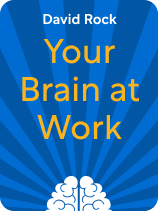

This article is an excerpt from the Shortform book guide to "Your Brain at Work" by David Rock. Shortform has the world's best summaries and analyses of books you should be reading.
Like this article? Sign up for a free trial here.
What’s the best way to start your work day? How should you handle stressful situations at work? How can you break through a creative impasse?
In Your Brain at Work, David Rock argues that, by understanding the neuroscience behind the brain’s functions, you can increase your productivity by working with your brain’s natural rhythms. He shares the neuroscience you need to know and some strategies to optimize this knowledge.
Keep reading for our overview of this interesting and practical book that will help you get the most out of your work day.
Overview of Your Brain at Work
Rock specializes in neuroleadership—a term he coined to describe the use of neurological research to determine the best practices in leadership. He co-founded the Neuroleadership Institute to advise business leaders on how to improve their effectiveness and to generate productive work environments in their organizations; companies like NASA and IBM are among Rock’s clients. While his ideas are primarily aimed at people in leadership positions, many of his strategies can apply to workers at any level.
In Your Brain at Work, Rock uses an extended metaphor of the theater to illustrate his ideas: The brain is the stage, your thoughts are the audience, and actors perform his methods in hypothetical work scenarios. Instead of incorporating the theater metaphor, we’ve chosen to focus on Rock’s theories underpinning it. We’ve organized his strategies into five sections: energizing your brain, regulating your emotions, collaborating with coworkers, unblocking your creativity, and keeping your focus.
How to Energize Your Brain
Rock claims that, when you’re aware of the fluctuation of your brain’s energy levels, you can plan your day around your ebbs and flows, enhancing your productivity.
The Science
Today’s work environment often requires a series of cognitive tasks that drain the brain’s energy rapidly, decreasing productivity. Cognitive tasks occur in the area of the brain called the prefrontal cortex and include complex processes like critical thinking, problem-solving, and planning. When performing a cognitive task, your brain summons a large, interconnected neural network that includes all related data.
When your brain is fully energized, sorting through your neural network is fast and easy. But, if you’re running low on energy, your brain struggles to focus on what’s important and can get distracted or overwhelmed with tangential information within that network.
How to Use the Science
Rock argues that, by understanding how cognitive tasks use energy, you can make predictions about what times of day will require the most energy and adequately prepare for them.
- Start your workday by prioritizing your tasks.
- Plan to work on your most important and energy-consuming task before other tasks.
- Alternate high- and low-energy tasks.
- Manage your energy levels directly. If you notice your brain tiring during an important task, or, if you can’t schedule a long break, you can try to increase your brain’s current energy levels by replenishing your glucose and oxygen.
- To refuel on glucose, eat or drink something sweet.
- To refuel on oxygen, take a walk or do some other light exercise.
How to Regulate Your Brain’s Emotions
In order to accurately manage your productivity, be aware of how the emotional part of your brain influences your mental energy. Rock explains that, while cognitive tasks occur in the front of the brain, emotions are processed in the center regions, collectively called the limbic system.
The Science
Rock classifies the signals we receive from our limbic system as toward and away emotions because they pull us emotionally either toward something or away from it. Toward emotions are positive feelings such as curiosity and happiness. When we experience toward emotions, our limbic system gives us a boost of energy. Away emotions are negative feelings like anxiety, fear, and sadness. Our cortisol and adrenaline levels heighten when we feel away emotions, and our brain wants to avoid the task. Since avoidance is not an option in most cases, we expend even more energy forcing ourselves to work on the task.
How to Use the Science
Rock illustrates that mindfulness—self-awareness—is the first step to harnessing your emotions for productivity. You have to be able to identify when you’re feeling away or toward emotions and then anticipate situations likely to trigger these emotions. After recognizing your emotional response, you can decide whether to use toward emotions to motivate you on a task or prevent away emotions from disrupting your task.
Before an Emotional Situation
Rock claims that you can minimize away emotions in stressful situations by preparing beforehand:
- Carefully select which situations you participate in.
- Adjust your situation.
- Deny away emotions your attention.
During an Emotional Situation
We need to take different approaches during an emotional situation:
- Express your emotion.
- Suppress your emotion.
- Reinterpret your emotion: This is the approach that Rock believes works best in a professional setting. You can decrease your away emotions by naming them and then reframing them in an optimistic light.
How to Get Your Brain to Collaborate
Even after you have a grasp on monitoring your prefrontal cortex’s energy levels and moderating your limbic system, your productivity can still be impacted by the people around you. While you can’t control the emotions and actions of others, you can understand which work situations trigger intense away emotions (and thus drain energy) as well as methods to mitigate these situations.
The Science
You feel the most threatened at work when you encounter change you weren’t prepared for. Your brain functions best when it’s at an equilibrium, so any change—big or small—puts your brain into a state of dissonance, or disorder. It takes time and energy to regain your balance. If your brain doesn’t have an adequate amount of either, you’re more likely to respond with unchecked emotion.
For leaders, it’s especially important to understand how unexpected change can cause threat responses in employees and diminish them when possible.
How to Use the Science
Rock points to two things that can upset the brain’s equilibrium, which leaders need to be particularly aware of: feedback and irregular procedures.
Giving Feedback
Feedback is inherently stressful. Here are some ways Rock recommends that leaders reduce the stress of feedback:
- Regularly provide positive feedback. The brain interprets positive feedback as things that are stable or even better than expected.
- Consider public positive feedback. When people receive praise in front of their peers, it creates an even stronger dopamine response. Be deliberate in providing feedback to employees equally.
- Normalize learning curves. One of the most significant pieces of feedback for an employee in a new position is reassurance that an adjustment period is normal.
- Focus “negative” feedback on the goal, not the employee’s weaknesses. Rock suggests asking the employee to reflect on how they can reach a specific goal.
- Be transparent. When feedback results in corrective measures, Rock says you should explain your reasoning and make sure the other party understands the full context of a situation.
Establishing Regular Procedures
To reduce potential threat responses in employees, Rock recommends that leaders stabilize as many aspects of a job as possible. The brain is in its comfort zone when it knows what to expect.
Here are some practices you can implement to establish consistency:
- Develop routines or templates for recurring tasks.
- Show your face in meetings. Facial expressions and body language help people understand what we’re communicating more fully.
- Share goals and accomplishments across departments.
- Create spaces where people can share their personal lives.
How to Reactivate Your Brain’s Creativity
Creativity is a cognitive function that requires a significant amount of mental energy. When your brain doesn’t have an adequate amount of energy or loses focus, you can experience a creative block.
The Science
Creativity is the process of taking various networks in our brains and creating new combinations. Rock calls the new network insight and a mental block to finding new connections an impasse. An impasse can occur when the prefrontal cortex is low on energy or the limbic system is distracting you from going through your networks efficiently.
How to Use The Science
Rock’s advice for finding a creative breakthrough is not to chase after inspiration but to methodically break the impasse.
The first step is to identify whether the source of the impasse is a lack of energy or an influx of away emotions:
- If the impasse stems from deficient energy, switch to a different, low-energy task.
- If you’re feeling too overwhelmed by away emotions, let your mind go idle for a while.
The second step is to reflect on your previous solutions. The final step is to try something outside of the pattern you’ve identified, and, once you have an idea, take immediate action.
How to Focus Your Brain
Rock writes that the key to understanding focus is to recognize how the brain processes various tasks and apply strategies that support the brain’s system.
The Science
Most tasks at work require several different brain functions, and your focus shifts as you operate each one. Thus, if you need to do something accurately and creatively, Rock argues that you shouldn’t multitask. Neuroscientists have observed that, when you add a second task, your brain experiences dual-task interference, in which each task prevents the other from being done properly, and the efficiency and quality of both tasks are cut almost in half.
How to Use the Science
To avoid dual-task interference, Rock provides some approaches to keeping your brain focused on one task at a time:
- Reduce distractions. Put your devices away when you’re trying to concentrate.
- Follow a routine. Creating routines can help you keep your focus, as you don’t have to waste energy thinking about next steps.

———End of Preview———
Like what you just read? Read the rest of the world's best book summary and analysis of David Rock's "Your Brain at Work" at Shortform.
Here's what you'll find in our full Your Brain at Work summary:
- How leaders can generate productive work environments
- How to schedule your day around your brain's energy levels
- Three steps to reactivate your creativity after a creative block






